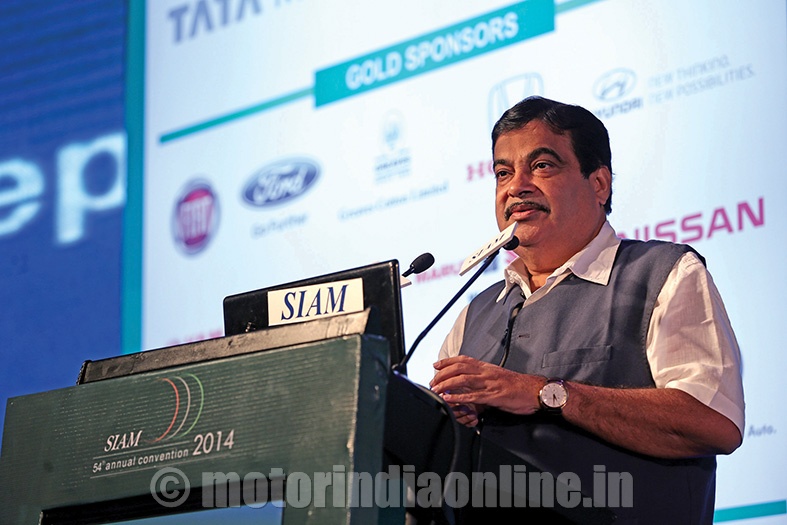Ready with a new scrapping policy for vehicles that will provide incentives for surrendering old polluting vehicles, the Government hopes that the policy will boost the automobile industry turnover over four-times to Rs. 20 lakh crores in the next five years.

The draft of the much-awaited policy is ready and would be put in public domain soon to seek views for the stakeholders and the general public.
“We will put the vehicle scrapping policy on website within a week to seek suggestions and, based on that, we will seek Finance Ministry’s approval. Once approved, it will be sent for the Cabinet nod,” Mr. Nitin Gadkari, Road Transport and Highways Minister, told PTI Economic Service in an interview.
The automobile industry turnover, which is about Rs. 4.5 lakh crores at present, will touch Rs. 20 lakh crores in the next five years with this policy, and India can be the “number one country to export the world’s best cars”, he said.
Giving further thrust to emission control measures, the draft norms for the ‘end of life’ policy are likely to provide about 50 per cent rebate in excise duty on new vehicles for buyers who surrender their polluting old ones.
“We will set up industrial clusters near ports that will manufacture automobile parts at half the market rate. The labour cost in India is less. Car parts like copper, steel, plastic and aluminium would be available in plenty from old vehicles, which would be recycled at these clusters,” he said.
The Government last month said it is planning 29 port-based coastal industrial centres under coastal economic zones which will boost exports by $110 billion, besides creating one crore new jobs. The clusters are planned in the vicinity of India’s top 12 major ports.
The Government is also considering giving financial incentives of up to Rs. 1.5 lakh on surrender of over-ten-year-old vehicles to check pollution and address road safety concerns, Mr. Gadkari had earlier said.
The proposed policy will follow the Government’s earlier announcement to implement stricter emission norms for vehicles from April 2020 despite the auto industry calling it an “extremely challenging” task.
India plans to leapfrog to stricter emission standards of Bharat Stage-VI fuel specifications, skipping BS-V norms altogether, from April 1, 2020. Under the proposed scrapping policy, people would get an incentive of up to Rs. 30,000 for discarding small vehicles like cars, while total benefits after taking into account the tax exemptions could be up to Rs. 1.5 lakh for big vehicles like trucks, the Minister had said earlier.
The new policy is likely to be valid for over-ten-year-old vehicles across the country.
The plan is to set up 8-10 industrial units near ports like Kandla which will give certificates for accepting old vehicles and also recycle vehicles from India and abroad, thus giving a boost to employment and the economy.
In another important move, it will be mandatory for public transport buses to install emergency buttons, CCTV cameras and vehicle tracking devices to ensure safety of women commuters.
“To ensure safety of women after the unfortunate Nirbhaya incident in December 2012, we have decided to make it mandatory for public transport buses to install emergency panic buttons, CCTV cameras and GPS-enabled vehicle tracking devices,” Mr. Gadkari said.
After launching a pilot project under which the Rajasthan State Road Transport Corporation will run 10 luxury and 10 ordinary roadways buses fitted with emergency buttons and CCTV cameras, a notification to have such devices in all public transport buses across the country was issued on June 2.
“We are looking at installation of panic buttons, CCTV cameras and other devices at the manufacturing stage itself. Bulk purchase of such items will bring down the cost of the devices”, he added.
The Ministry issued these draft rules earlier this month under the Motor Vehicles act and had sought comments from stakeholders, including vehicle manufacturers.
Under the proposed notification, transport vehicles with a seating capacity of over 23 passengers will mandatorily have CCTV cameras that will be connected to the global positioning systems and will be monitored by the local police control room.
Mr. Gadkari has further said that in case of any untoward event a women passenger would be able to press the emergency button which in turn will transfer the information to the nearest local police station via GPS. Once the emergency signal is triggered, the CCTV cameras will start displaying live footage of the bus at the central control room. Besides, if a vehicle deviates from its prescribed route (monitored through the GPS devices), the system will start sending signals tracking its movement to the control room.
Once these initiatives are implemented, they will make women safer on roads, Mr. Gadkari has said, adding that the need for the move was felt in the wake of the unfortunate Nirbhaya incident in December 2012.
Under the Rajasthan Government initiative known as ‘Mahila Gaurav’, the emergency button functionality can be used by passengers to alert the officials and, as soon as the panic button is pressed, information of the bus and its location is sent to the designated phone number (presently, depot chief manager’s mobile number), while video history of the bus can be used in case of any untoward incident.
– PTI Economic Service
